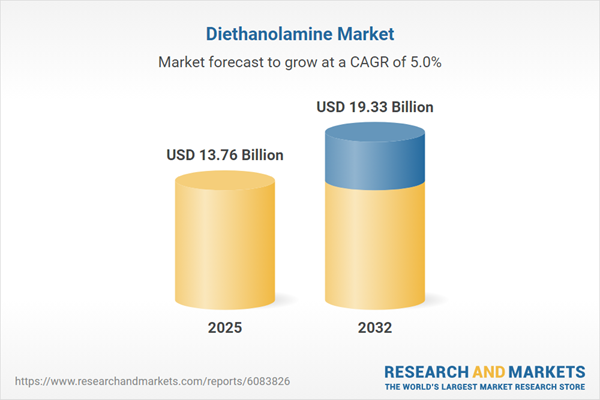Speak directly to the analyst to clarify any post sales queries you may have.
Senior decision-makers in chemicals, energy, and manufacturing must navigate a critical phase in the diethanolamine market, driven by evolving technology, regulatory change, and international supply chain demands. This report distills vital intelligence to help your organization adapt and lead within a dynamic global landscape.
Market Snapshot: Diethanolamine Market Size and Growth Prospects
The diethanolamine market is experiencing steady growth, expanding from USD 13.10 billion in 2024 to USD 13.76 billion in 2025, with a projected compound annual growth rate (CAGR) of 4.98% through 2032, ultimately reaching USD 19.33 billion. This expansion is shaped by ongoing advances in production technologies, sustainability imperatives, and the influence of shifting global trade and regulatory environments. The market’s stability, despite volatility in related chemical value chains, underscores its significance to both strategic planning and risk management for B2B players.
Scope & Segmentation
- Grade: Purified and technical grades, supporting diverse use cases from high-precision applications to foundational industrial processes.
- Applications: Gas treatment such as acid gas and hydrogen sulfide removal; metal processing sectors including electroplating, degreasing, pickling, and coating; personal care, spanning cosmetics, haircare, and skin care; and surfactant manufacturing, incorporating amphoteric, anionic, cationic, and nonionic formulations.
- End Use Industries: Agriculture (crop protection and fertilizers); oil & gas (across downstream, midstream, and upstream segments); paints & coatings (serving automotive, decorative, and industrial needs); personal care (hair, oral, and skin care); textile manufacturing (fabric finishing, yarn dyeing).
- Regions: Americas (including the United States, Canada, Mexico, Brazil, Argentina, Chile, Colombia, Peru); Europe, Middle East & Africa (such as the United Kingdom, Germany, France, Russia, Italy, Spain, Netherlands, Sweden, Poland, Switzerland, United Arab Emirates, Saudi Arabia, Qatar, Turkey, Israel, South Africa, Nigeria, Egypt, Kenya); Asia-Pacific (comprising China, India, Japan, Australia, South Korea, Indonesia, Thailand, Malaysia, Singapore, Taiwan).
Key Takeaways for Strategic Decision-Making
- Process efficiency and environmental management are advancing as catalyst innovation, process intensification, and digital tools become central, supporting sustainable operations without sacrificing productivity.
- Renewed focus on sustainable chemistry is influencing adoption of closed-loop recovery techniques and increased use of bio-based feedstocks, especially in markets facing stricter environmental oversight.
- End users prioritize purified diethanolamine for personal care and complex surfactant formulations, whereas technical grade continues to underpin essential operations in gas treatment and metal processing sectors.
- Regional markets show contrasting adoption patterns: established economies emphasize innovation and regulatory compliance, while emerging economies contribute to market volume through growing infrastructure and manufacturing activity.
- Industry partnerships with biotechnology firms and investments in digital transformation—from predictive analytics to IoT-enabled process management—are enabling greater agility and faster response to market shifts.
Tariff Impact on International Competitiveness
The introduction of United States tariffs on diethanolamine imports in 2025 has accelerated sourcing diversification and the search for alternative suppliers, helping to limit cost exposure and enhance resilience across supply networks. Exporters outside the US respond with increased efforts to capture lost market share, while domestic organizations adjust sourcing models and contract structures to preserve operational margins in a shifting competitive context.
Methodology & Data Sources
This report utilizes a methodical approach, combining extensive secondary research, structured executive interviews, and seasoned expert consultation. Data triangulation, analysis of historical trends, and cross-functional panel reviews build a strong basis for objective market insights. Coverage includes reviews of supply-demand balance, cost structures, and emerging innovation trends.
Why This Report Matters
- Enables senior leaders to develop robust sourcing, manufacturing, and partnership strategies rooted in evidence-based assessment of drivers and threats.
- Supports clear alignment of growth opportunities by market segment and geography, aiding investment and resource prioritization decisions.
- Empowers management teams to anticipate evolving risks and regulations, supporting resilient, future-ready operations across the value chain.
Conclusion
As the diethanolamine market evolves through innovation, regulatory updates, and changing trade flows, proactive focus on sustainability, adaptability, and collaborative development will be fundamental to shaping industry leadership and long-term success.
Table of Contents
3. Executive Summary
4. Market Overview
7. Cumulative Impact of Artificial Intelligence 2025
Companies Mentioned
The companies profiled in this Diethanolamine market report include:- Dow Inc.
- Nouryon Chemicals International B.V.
- BASF SE
- Evonik Industries AG
- Stepan Company
- Huntsman International LLC
- LyondellBasell Industries N.V.
- Clariant AG
- PCC SE
- Kaneka Corporation
Table Information
| Report Attribute | Details |
|---|---|
| No. of Pages | 196 |
| Published | November 2025 |
| Forecast Period | 2025 - 2032 |
| Estimated Market Value ( USD | $ 13.76 Billion |
| Forecasted Market Value ( USD | $ 19.33 Billion |
| Compound Annual Growth Rate | 4.9% |
| Regions Covered | Global |
| No. of Companies Mentioned | 11 |









